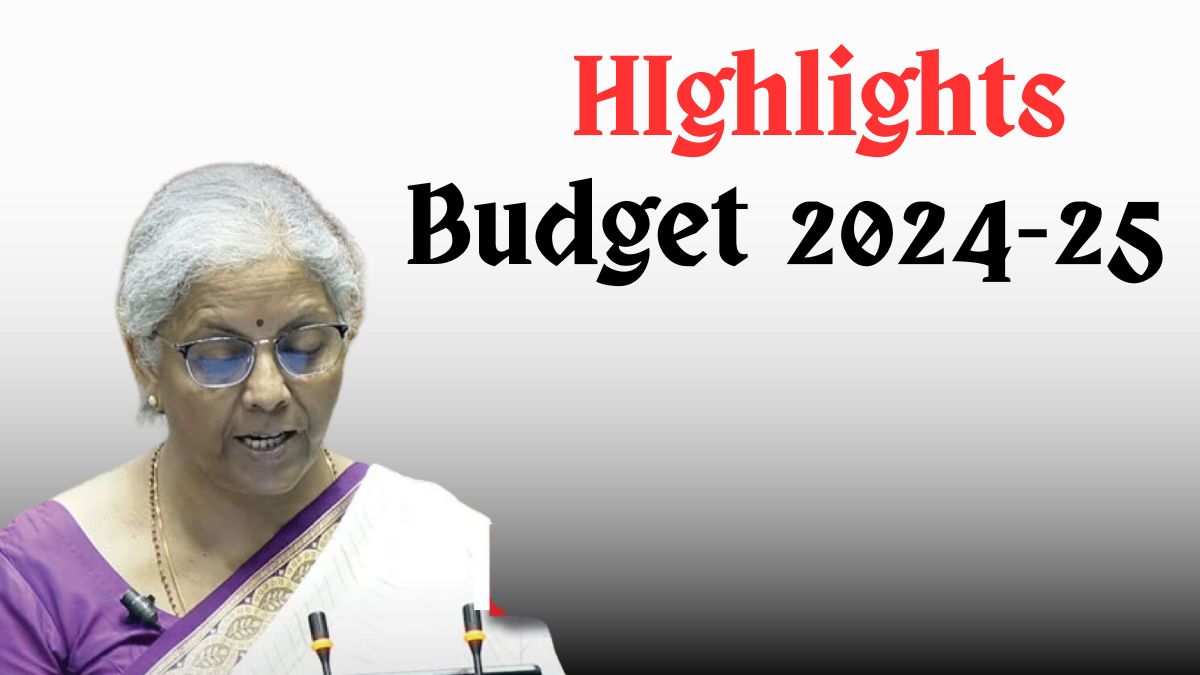The Budget for the fiscal year 2024-25 has been a topic of
significant interest and debate, as it aims to address a multitude of economic
challenges while fostering sustainable growth. As economies worldwide recover
from the disruptions caused by the COVID-19 pandemic, this budget comes at a
crucial juncture, seeking to balance fiscal prudence with the need for robust
public spending.
The key highlights of this budget reflect a comprehensive
approach towards inclusive development, technological advancement, and
environmental sustainability.
Economic Context
The global economic landscape in 2024 remains complex, with
varying degrees of recovery across regions. In this backdrop, the Budget
2024-25 is framed to address domestic economic challenges such as inflation,
unemployment, and sluggish industrial growth, while also capitalizing on
emerging opportunities in the technology and green energy sectors.
Key Priorities
1. Fiscal Consolidation
and Deficit Management
One of the primary
objectives of the Budget 2024-25 is to maintain fiscal discipline. The
government has set a fiscal deficit target of 4.5% of GDP, a moderate reduction
from the previous year's target. This aim is to be achieved through a
combination of expenditure rationalization and revenue augmentation. Measures
include a review of subsidies, increased efficiency in public spending, and
broadening the tax base.
2. Infrastructure
Development
Significant allocations have been made for infrastructure
projects, reflecting the government's commitment to bolstering economic growth
through improved connectivity and industrial development. The budget allocates
$150 billion for roads, railways, and urban infrastructure projects. A new
National Logistics Policy is also introduced to streamline supply chains and
reduce logistics costs.
3. Agriculture and
Rural Development
The budget emphasizes the importance of the agricultural
sector and rural economy. With a substantial allocation of $75 billion,
initiatives are focused on enhancing irrigation facilities, providing direct
income support to farmers, and promoting agri-tech innovations. The Pradhan
Mantri Kisan Samman Nidhi (PM-KISAN) scheme continues with increased funding, ensuring
financial assistance to millions of farmers.
4. Healthcare and
Education
The pandemic underscored the need for robust healthcare
infrastructure. The budget proposes an allocation of $100 billion for
healthcare, with a focus on primary healthcare, vaccination drives, and the
establishment of new medical colleges. In education, the allocation stands at
$90 billion, aiming to bridge the digital divide, improve educational
infrastructure, and promote skill development programs.
5. Green Economy and
Sustainable Development
Environmental sustainability is a cornerstone of the Budget
2024-25. The government has announced a Green Transition Fund of $50 billion to
support renewable energy projects, electric vehicle infrastructure, and
sustainable farming practices. Additionally, incentives for industries to adopt
eco-friendly technologies are introduced, aligning with the global commitment
to reducing carbon emissions.
Revenue Generation
Strategies
To support these ambitious spending plans, the government
has outlined several revenue-generating strategies. These include:
Tax Reforms: The introduction of a simplified tax regime aims to make compliance easier and broaden the tax base. The corporate tax rate remains competitive, encouraging investment while ensuring fair tax contributions from high-income earners.
Disinvestment and Privatization: The budget continues the trend of disinvestment in public sector enterprises, targeting $20 billion in proceeds. This includes strategic sales and initial public offerings of state-owned entities.
Digital Economy: Leveraging the burgeoning digital economy, the budget proposes measures to boost e-commerce, fintech, and start-up ecosystems. Digital transactions are incentivized, and a framework for regulating cryptocurrencies is introduced, ensuring a balance between innovation and financial stability.
Social Welfare and Inclusive Growth
Inclusivity is a significant theme in this budget, with
targeted programs for marginalized communities. Allocations for social welfare
schemes, such as housing for all, women and child development, and skill
training for the underprivileged, have been increased. The budget also proposes
the establishment of a National Social Security Fund to provide a safety net
for the informal sector workers.
Challenges and
Criticisms
Despite its ambitious plans, the Budget 2024-25 faces
several challenges. The ability to meet fiscal deficit targets while ensuring
adequate public spending remains a critical concern. Inflationary pressures and
global economic uncertainties could impact the projected growth rates and
revenue collections. Additionally, the effectiveness of disinvestment plans and
tax reforms in generating the anticipated revenue is yet to be seen.
Critics argue that while the budget addresses immediate
economic concerns, it lacks a long-term vision for structural reforms. There
are concerns about the adequacy of allocations for healthcare and education,
given the scale of the challenges in these sectors. Moreover, the emphasis on
infrastructure and industrial development might overshadow the urgent need for
environmental conservation and climate resilience.
Which
product price will be cheaper and higher in budget 2024-25
The Budget 2024-25 introduces various measures that are
likely to impact the prices of several products. Based on typical budgetary
trends and announcements, here's an analysis of which product prices might
become cheaper or higher:
Which Products Likely to Become Cheaper in Budget 2024-25
1. Electric Vehicles
(EVs)
Reason: Increased subsidies and incentives for EV
manufacturing and purchase. Investment in EV infrastructure, such as charging
stations, also reduces costs associated with EV usage.
2. Renewable Energy
Products
Reason: Support for renewable energy projects,
including solar panels and wind turbines, often translates to lower costs for
related products due to subsidies and tax incentives.
3. Healthcare and
Pharmaceutical Products
Reason:
Higher allocation to the healthcare sector may include measures to reduce
prices of essential medicines and medical devices. Increased funding can lead
to more subsidies and better access to affordable healthcare.
4. Agricultural
Inputs
Reason:
Enhanced support for the agricultural sector can lead to lower prices for
fertilizers, seeds, and other agricultural inputs due to subsidies and
government-backed procurement schemes.
5. Education Tools
and Digital Devices
Reason:
Investments in bridging the digital divide and improving educational
infrastructure might include subsidies or reduced taxes on laptops, tablets,
and internet services to promote online education.
Which Products Likely to Become More Expensive?
1. Luxury Goods
Reason: Higher taxes on luxury items as
part of efforts to increase revenue from high-income earners. This often
includes items like high-end cars, jewelry, and designer clothing.
2. Fossil Fuels
Reason: Increased
taxes on fossil fuels as part of green energy initiatives. This could include
higher excise duties on petrol, diesel, and coal to discourage their use and
promote cleaner alternatives.
3. Tobacco and
Alcohol
Reason: Increased
sin taxes to discourage consumption and raise revenue. These products are often
targeted for higher duties and taxes in budgets aiming to promote public
health.
4. Plastic Products
Reason: Higher
taxes or bans on single-use plastics as part of environmental sustainability
measures. This could lead to increased costs for plastic packaging, utensils,
and other disposable plastic products.
5. Imported Consumer
Goods
Reason: Increased
customs duties on certain imported goods to promote domestic manufacturing.
This could make electronics, certain foods, and luxury items more expensive if
they are primarily sourced from abroad.
Additional
Considerations
Food and Essential
Commodities: While the budget might aim to keep essential food prices
stable, external factors like global commodity prices, weather conditions, and
supply chain disruptions can also influence prices. The government may
introduce measures to control inflation in essential goods.
Housing and Real
Estate: Changes in tax policies and incentives related to housing loans and
real estate investments could impact property prices. Efforts to promote
affordable housing could make homes cheaper for first-time buyers.
Tech Gadgets and
Electronics: Depending on the specific incentives or duties imposed, prices
of gadgets and electronics could vary. Subsidies for tech start-ups and
manufacturing might reduce prices, while higher import duties could increase
costs.
What are the Income Tax Slabs for Individuals?
For Individuals below 60 Years of Age:
|
Income
|
Below Age
|
Tax Rate
|
|
2,50000
|
60
|
Nil
|
|
Income
|
Below Age
|
Tax Rate
|
|
2,50000-500000
|
60
|
5%
|
|
Income
|
Below Age
|
Tax Rate
|
|
500001- 1000000
|
60
|
10%
|
|
Income
|
Below Age
|
Tax Rate
|
|
10,00,001 to 12,50,000
|
60
|
15%
|
|
Income
|
Below Age
|
Tax Rate
|
|
12,50,001 to 15,00,000
|
60
|
30%
|
|
Income
|
Below Age
|
Tax Rate
|
|
Above 15,00,000
|
60
|
30%
|
For Senior
Citizens (60 Years to 80 Years):
|
Income
|
Above Age
|
Tax Rate
|
|
3,00,000
|
60-80 Years
|
Neil
|
|
Income
|
Above Age
|
Tax Rate
|
|
3,00,001 to 5,00,000
|
60-80 Years
|
5%
|
|
Income
|
Above Age
|
Tax Rate
|
|
5,00,001 to 10,00,000
|
60-80 Years
|
15%
|
|
Income
|
Above Age
|
Tax Rate
|
|
10,00,001 to 12,50,000
|
60-80 Years
|
15%
|
|
Income
|
Above Age
|
Tax Rate
|
|
12,50,001 to 15,00,000
|
60-80 Years
|
20%
|
|
Income
|
Above Age
|
Tax Rate
|
|
Above 15,00,000
|
60-80 Years
|
30%
|
For Super
Senior Citizens (Above 80 Years):
|
Income
|
Above Age
|
Tax Rate
|
|
Above 5,00,000
|
80 Years
|
Nil
|
|
Income
|
Above Age
|
Tax Rate
|
|
5,00,001 to 10,00,000
|
80 Years
|
10%
|
|
Income
|
Above Age
|
Tax Rate
|
|
10,00,001 to 12,50,000
|
80 Years
|
15%
|
|
Income
|
Above Age
|
Tax Rate
|
|
12,50,001 to 15,00,000
|
80 Years
|
20%
|
|
Income
|
Above Age
|
Tax Rate
|
|
Above 15,00,000
|
80 Years
|
20%
|
Surcharge
and Cess
1. Surcharge:
- 10% of income tax if total income
exceeds Rs 50 lakh up to Rs1 crore.
- 15% of income tax if total income
exceeds Rs 1 crore up to Rs2 crore.
- 25% of income tax if total income
exceeds Rs 2 crore up to Rs5 crore.
- 37% of income tax if total income
exceeds Rs5 crore.
2. Health and
Education Cess:
- A cess of 4% on the total income tax plus
surcharge
Deductions and Exemptions
1. Standard
Deduction:
- A standard deduction of Rs 50,000 for salaried individuals
2. Section 80C:
- Deductions up to Rs 1.5 lakh for investments in specified instruments such as Public Provident Fund (PPF), National Savings Certificate (NSC), and Equity Linked Savings Scheme (ELSS).
3. Section 80D:
- Deductions for medical insurance premiums up to Rs 25,000 for individuals and Rs 50,000 for senior citizens.
4. Section 24(b):
- Deduction on home loan interest up to Rs 2 lakh for a self-occupied property.
5. Section 80TTA:
- Deduction up to Rs 10,000 on interest earned from savings accounts.
6. Section 80EE:
- Additional deduction up to Rs 50,000 for interest on home loan for first-time homebuyers.
What is the New Tax
Regime vs. Old Tax Regime?
The Budget 2024-25 continues to offer taxpayers the option
to choose between the new tax regime and the old tax regime.
1. New Tax Regime:
- Lower tax rates with fewer exemptions and deductions.
- Suitable for taxpayers who do not have significant investments or expenditures that qualify for deductions.
2. Old Tax Regime:
- Higher tax rates with multiple exemptions and
deductions.
- Beneficial for taxpayers who can claim
substantial deductions and exemptions.
Conclusion
The income tax structure in Budget 2024-25 aims to simplify
compliance and provide relief to middle-income groups while ensuring adequate
revenue generation. The choice between the new and old tax regimes offers
flexibility to taxpayers based on their financial situation and planning. The
emphasis on broadening the tax base and streamlining tax administration
reflects the government's commitment to fiscal prudence and economic growth.

